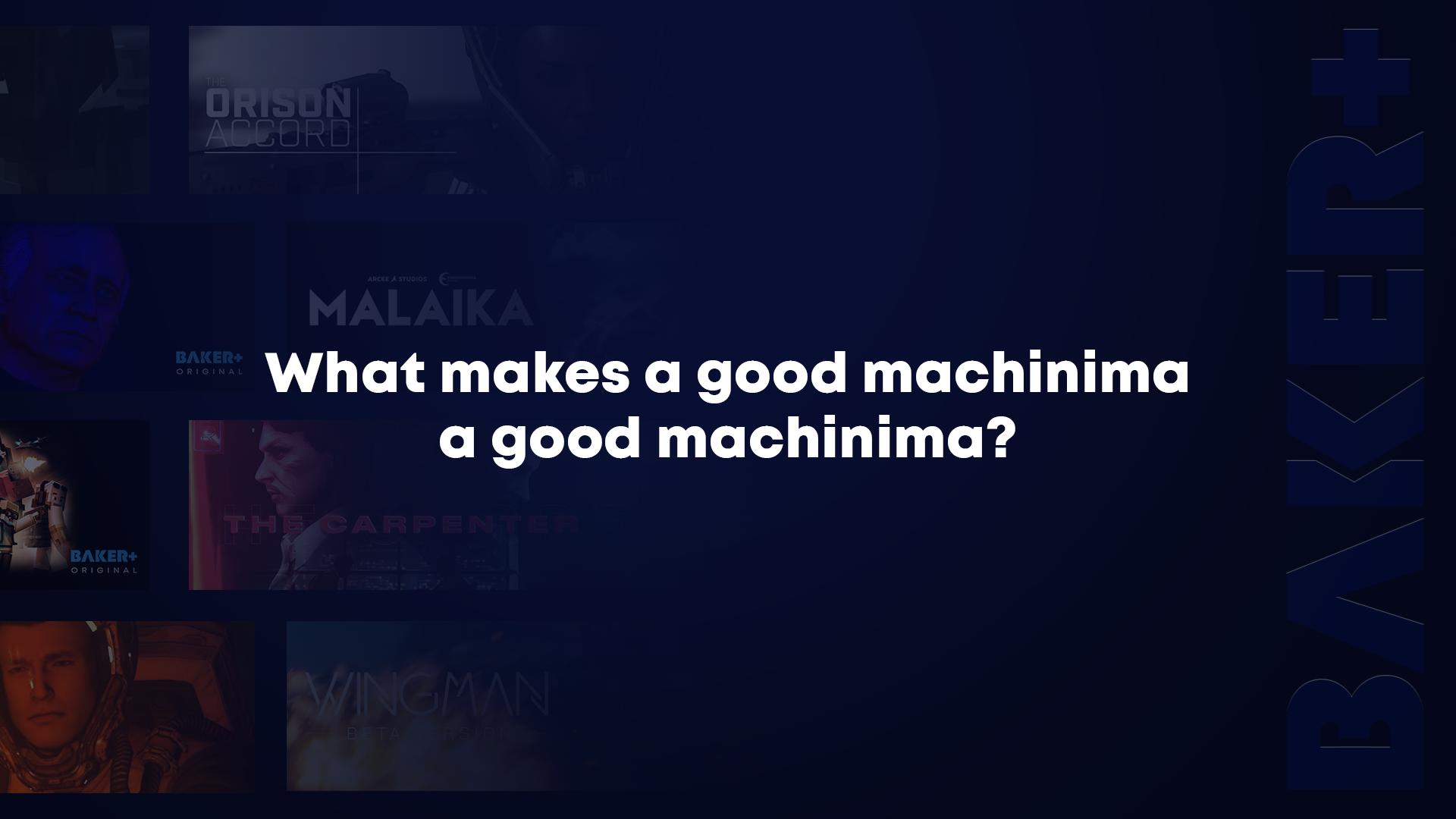
What Makes A Machinima A Good Machinima?
A question everyone making machinimas should ask themselves prior to constructing their artwork.
- How do I make a good machinima?
- What points do I need to consider?
- What are popular mistakes?
- How do I write a involving story?
- and how do I…
Baker+ is the leading streaming service exclusive to machinimas. We have established a bar for quality among the many works created on a daily basis by all creators, fans and visionaries. This guarantees that all works distributed on Baker+ have a certain quality level. Over the two years we have been existing, we learned more and more how to evaluate machinimas. What aspects can we evaluate on an objective basis and what aspects we cannot?
We have come to realize that judging the story is the hardest part, because the story is the most subjective. The Director of Distribution may not like the story personally, but many more people might. Our resolution up to this point is: If there are no major plot holes, weaknesses or blatantly bad stories, we primarily focus on the production quality. If the story is questionable, it will be shown to multiple people to gain an average opinion on whether the story is bad or not. If you want to find out what our quality expectations are, visit our affiliate program page.
The most important part is THE STORY.
It might sound contradictory to the paragraph above, but listen: No matter how good your movie may look, if the story sucks, the movie sucks. If the visuals don’t hold up, you can practically throw the film away. However, if you have “okay” or semi-good visuals, but the story is really good, the film will hold up – and have a place on Baker+. Don’t hold off with making a machinima/film, just because you are afraid that the visuals will not compare with others. That is the first mistake many do. Then the machinima ends before it was even started.
There are many good tutorials, books, videos and examples that teach great storywriting. The trick is to realize that YOU are writing the story. Write what you think is right for the story. Even if it’s inspired by an existing work, you are putting your spin on it and make it your own. At the end of the day, you have to be happy with it.
“I don’t try to guess what a million people will like. It’s hard enough to know what I like.”
John Huston, OSCAR-Winning Director and Actor
Machinimas offer the best way to roam in your creativity and visions. You do not need a million budget to realize a good story. You can tell that story from the comfort of your own home with little to no extra cost.
“You can’t forget about the visuals, though!”
One cannot deny that visuals do play a crucial part in machinimas. Visuals often times attract the viewer. Then they stay for the story. If you manage to find the perfect mix between story and visuals, you have a good, if not very good, machinima on your hands. One thing that puts it all together is the style. As a director, screenwriter or director of photography it is key to find your own style. Make no mistake. You are very unlikely to find your 100% permanent style on your first projects or ever. The more projects you make, the more your style evolves into something unique and that is what really makes a film successful. If you copy other director’s styles and ideas, it’s not going to bring you the success you want in the long run.
“Besides the most important thing – the story – it is also very important that you find your own style – your own film look! Create a machinima style that sets you apart. It starts with the choice of your resource pack, shader and skin resolution. Produce films that have your signature, that could be recognized and assigned to you as soon as somebody sees them. Find that style and stick to it. You can always make things better and polish even more, but consistency is key.
Another essential tip from somebody who had to deal with it many times: SHOOT, SHOOT, SHOOT! Don’t worry if your movie doesn’t turn out the way you imagined. Finish the project and get better on the next one. Perfection shatters dreams.”
Louis Angerer from ARCEE Studios, Director and Writer of “ABFAHRT” (2021)
Filmmaking is like cooking. You have to get the ingredients first before being able to cook the meal. Think about it: The script is usually the first thing you get and prepare. The actors are the flavors and the crew the main ingredients. Shooting is mixing all the ingredients together and post-production is when you cook your meal. At the end, you get your final meal – or in this case, the film.
Leave people in an awe.
If your machinima doesn’t stand out of others, you might drown. Doing nothing special in a machinima may seem the safest option of all, but haven’t the most people in the filmmaking industry found success by being bold? By trying something new or doing something different than anybody else? You can’t set standards, if you’re always following the standards.
“Good machinima is not necessarily about having the best graphics, the best sound or the best sets. Rather, I think it’s especially important to make the audience forget within the first few minutes that they’re watching a machinima at all. All the parts of the film have to work together so that after the credits, the audience feels like they’re leaving a movie theater saying, “Damn. That was awesome!”
Florian Torgau from PhoenixMeda Digital, VFX Supervisor of “ABFAHRT” (2021)
But the most important question to ask oneself is: Why am I making machinimas? No one but you can give you an answer to this question. Here are a few pointers to help you find that answer:
- Am I making machinimas to be original? To create own stories and characters.
- Am I making machinimas just as a hobby with no ambition to become an industry professional in the future?
- Am I making machinimas as means to visualizing my creativity with little to no budget?
- Am I making machinimas just for fun to add to existing universes (fan films, etc.) to see what I can do?
Please consider that none of these options are bad or less good than another. Each has its own right to exist. It is merely what you need to figure out for yourself. You can also combine them. For example: You want to make original stories, but have no interest in becoming an industry professional, because you already have found your job passion and this is your creative outlet.
You are going to learn that a lot of things in the film industry and the world even, are based on your mindset. Of course, there can be mitigating circumstances that can ease or harden the success, but in the end it is your mindset you are building upon. If you are set on the determination that everything is not going to be successful, it will not be. If you put in enough effort and time, you are much more likely to succeed.
The final key to making a good machinima is to mix it all together. The story, the visuals and the style.
“When it comes to machinima productions, I actually pretty much always pay attention to the following three points:
- The creativity of the story and the pacing;
- The visual quality: A coherent and continuos graphic style and matching VFX;
- The believability of the audio backdrop and the film score
If the realization of these three criteria inspires me, then I can speak of a very good machinima.”
Marlon Funk, Executive Producer at AREON Pictures
Conclusion
The most important thing is that YOU are happy with your machinima. Any other commendations, awards or popularity of such will be an additional reward for the hard work you have dedicated to your machinima. Of course, this is easier said than done, but you are going to make it easier for yourself, if you make what you want, not what you think the audience might want – because surprise: Usually the audience wants to see your product, that’s why they are there.
We hope, you enjoyed this blog article. If you would like to see more of these, be sure to let us know and we would be happy to hear your feedback!

Director, Original Productions and Acquisitions